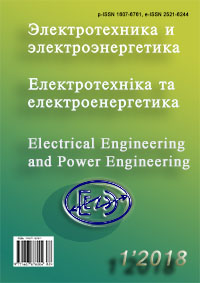PWM CONTROLLER'S MODELS FOR INVESTIGATION ACS IN SPICEFAMILY ECAD PROGRAMS
DOI:
https://doi.org/10.15588/1607-6761-2018-1-7Keywords:
ACS, PWM Controller, ECAD, SPICE, modeling, simulation, behavioral elements, macromodel, adequacyAbstract
Purpose. To improve simulation and design of Automatic Control Systems in the SPICE-compatible programs and to obtain separate economic and universal macromodels of PWM controller. Development of an PWM controller economical macromodel for the study of automatic control systems (ACS) in computer-aided design (ECAD) programs, which does not generate algorithmic failures in comparison with the existing models of PWM.
Findings. Analysis of SPICE-family applications’ mathematical basis allowed to classifying existing models of PWM-controllers, defining their suitability for ACS simulation. The criteria for the synthesis of new models have been defined. For the SPICE 3G algorithms, the Switch and Averaged models based on behavioral elements has been developed. Universal and economical PWM controller macromodel based on the simple algorithm for determining the output signal with minimum numbers of input parameters has been designed. For the Automated Measuring magnetic susceptibility System, the macromodel of quasi-PWM signal generator have been designed, which is used in the compensation subsystem. This model is different from the existing ones: it synthesizes the staircase output signal instead the pulse one, thus, there is direct control of the amplitude of the output signal, which is taken averaged. The adequacy of the models is confirmed as comparison of the simulation results during investigations of the model already existing in the SPICE program, as well as the results of experiments with real ACS. The modeling of the PWM controller was carried out on the basis of behavioral elements from the ECAD library, simulation (solution of algebra-differential equations systems with programming elements) is based on SPICE algorithms. The object of the study was the simulation process of ACS with the pulse-width principle of adjusting the output value. The subject of the research are the models of PWM controllers.
Originality. The new macromodel of PWM controller that meets the criteria of adequacy, reliability and economy, synthesized on the basis of a new approach in modeling objects at the macro level in accordance with the theory of automatic control. Macromodels based in capabilities of behavioral modeling in the program of computer-aided design in Electronics (ECAD). As part of the compensation system studying, the new controller model has been developed, that turns pulse-width modulated signal into amplitude-modulated signal by a certain algorithm. This approach (obtaining a quasi-PWM signal) made it possible to significantly simplify the control unit model, and the model of ACS at whole.
Practical value. PWM macromodels expands the mathematical support of ECAD, reduces the probability of the appearance of algorithmic failures and accelerates the modeling of ACS in ECAD. Approach, which used during its synthesis, allows us to build similar models for other software (CAS, CAE).
References
[1] Vasylenko, O. V. (2015). Analiz prohram dlya modelyuvannya mekhatronnykh system [Analysis of programs for mechatronic systems modeling]. Radioelektronika, informatika, upravlenie, 3, 80-88. DOI: 10.15588/1607-3274-2015-3-10 [in Ukrainian]
[2] General Purpose PWM Controllers. Model Library [Electronic resource]. – Access mode: http://www.pspice.com/power-management/generalpurpose-pwm-controllers#block-systemmain/document [in English]
[3] Baldoni, Cristoforo. Straightforward Method to Design and Simulate with SPICE the Loop Compensation Controller for All Switching Power Supplies [Electronic resource]. – Access mode: http://www.youspice.com /straightforward-methoddesign-simulate-spice-loop-compensation -controllerswitching-power-supplies / document [in English]
[4] Micro-Cap 11, Electronic Circuit Analysis Program Reference Manual, Spectrum Software [Electronic resource]. – Access mode: http://www.spectrumsoft.com/down/rm11.pdf/document [in English]
[5] UC1845 Current Mode PWM Controller DATASHEET, Texas Instruments [Electronic resource]. –Access mode: http://www.ti.com /product/ UC1845/document [in English]
[6] Basso, Christophe (1996). Write your own generic SPICE Power Supplies controller models. Manuscript for PCIM US [Electronic resource]. – Access mode:
http://www.www.intusoft.com/articles/pwmtut.pdf /document [in English]
[7] Andrienko P. D., Shilo S. I., Kaplienko O. O. (2016). Doslidzhennia dynamichnykh rezhymiv elektrodvyhuna poslidovnoho zbudzhennia z impulsnymy skhemamy rehuliuvannia elektropryvodu [Research of successive excitation electric motor dynamic modes with pulsed schemes of the electric drive regulation]. Electrical Engineering and Power Engineering, 2, 51-58. DOI 10.15588/1607-6761-2016-2-6 [in Ukrainian]
[8] Potapenko E.M., Dushinova E.V., Kazurova A.E., Deev S.G. (2010) Lineynaya dinamicheskaya model asinhronnogo dvigatelya s vektornyim upravleniem [The linear mathematical model of induction drive with vector control]. Electrical Engineering and Power Engineering, 2, 25-36. [in Russian]
[9] Modeling the Pulse-Width Modulator [Electronic resource]. – Access mode: https://www. allaboutcircuits.com /technical-articles/ modelling-the-pulsewidth-modulator/ document [in English]
[10] Kendall, Ray. (2002). Modular macromodeling techniques for SPICE simulators, EDN [Electronic resource]. – Access mode: https://www.edn.com/design/analog/4348119/Modular-macromodelingtechniques-for-Spice-simulators/document [in English]
[11] Snizhnoi, H.V. Zhavzharov Ye.L. (2012). Avtomatyzovana ustanovka dlia vy-znachennia mahnetnoi spryiniatlyvosti kryts ta stopiv. Visnyk Natsionalnoho tekhnichnoho universytetu Ukrainy "Kyivskyi politekhnichnyi instytut". Seriia "Radiotekhnika. Radioaparatobuduvannia", 49, 136-141. [in Ukrainian]
[12] Vasylenko, O.V. (2015). Modeling of multidomain Automatic Control Systems in ECAD. Visnyk Akademii mytnoi sluzhby Ukrainy. Seriia: Tekhnichni nauky, 1, 13-19.
Downloads
Published
How to Cite
Issue
Section
License
Copyright (c) 2018 VASYLENKO O. V., SNIZHNOI G. V.

This work is licensed under a Creative Commons Attribution 4.0 International License.
Creative Commons Licensing Notifications in the Copyright Notices
Authors who publish with this journal agree to the following terms:
Authors retain copyright and grant the journal right of first publication with the work simultaneously licensed under aCreative Commons Attribution License that allows others to share the work with an acknowledgement of the work's authorship and initial publication in this journal.
Authors are able to enter into separate, additional contractual arrangements for the non-exclusive distribution of the journal's published version of the work (e.g., post it to an institutional repository or publish it in a book), with an acknowledgement of its initial publication in this journal.
Authors are permitted and encouraged to post their work online (e.g., in institutional repositories or on their website) prior to and during the submission process, as it can lead to productive exchanges, as well as earlier and greater citation of published work.

